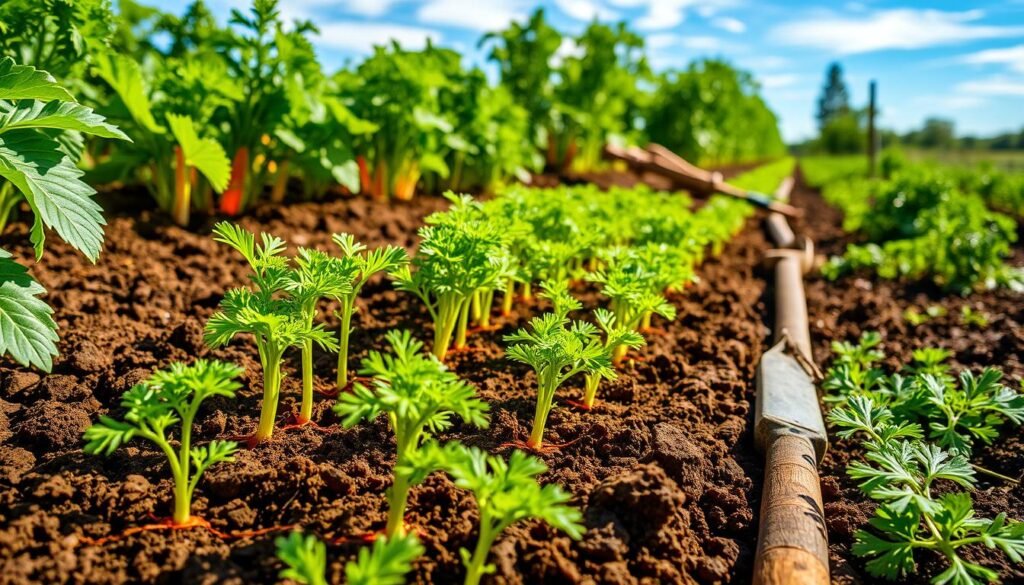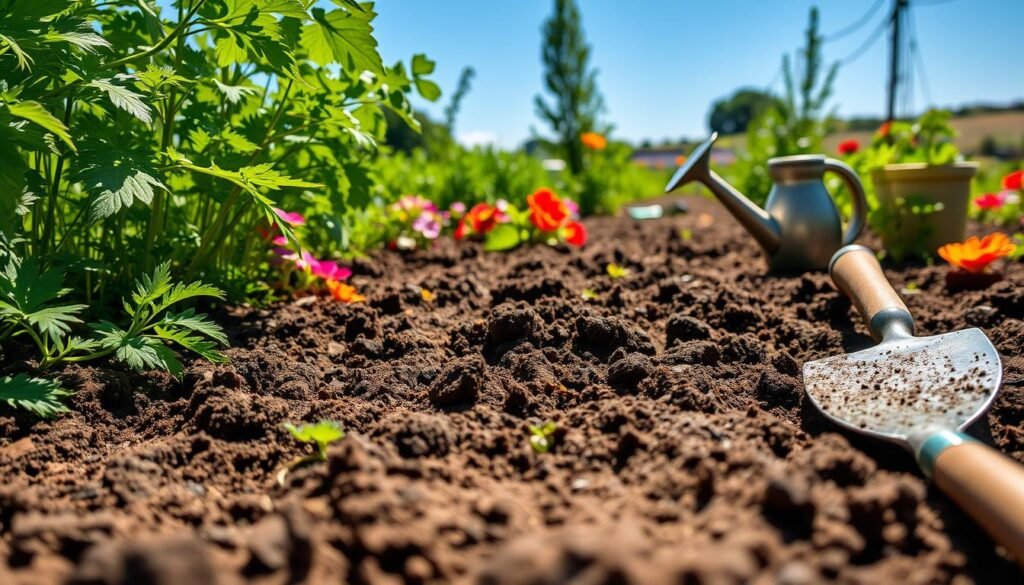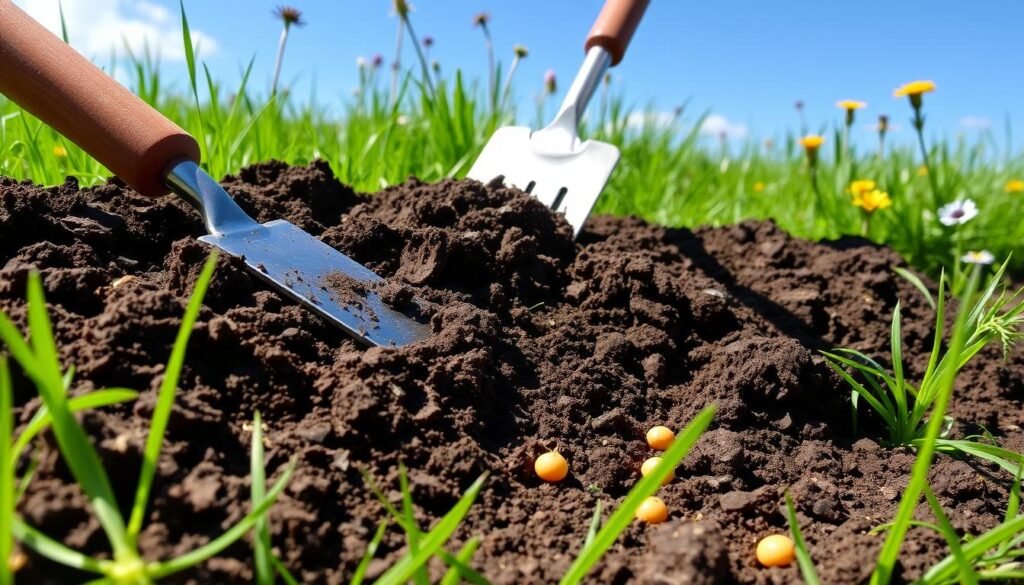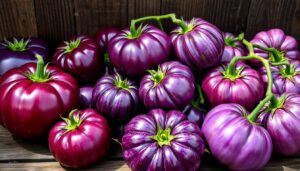Did you know that nearly 70% of vegetable crops grown in northern areas have short maturity times? They can be planted many times during the summer. This is great news for gardeners in Oklahoma, who can grow carrots even in June. Welcome to our guide on how to plant carrots in June Oklahoma. Here, you’ll learn the key techniques and best practices for growing vegetables Oklahoma style.
In this guide, you’ll find out about Oklahoma’s unique climate. You’ll also learn about the best carrot varieties for our conditions. Plus, you’ll discover the best ways to plant and care for your carrots. With the right steps, you can enjoy a big harvest of fresh, healthy carrots all summer long. Let’s get started!
Table of Contents
Understanding Carrot Varieties for Oklahoma
When growing carrots in Oklahoma, it’s key to know the right varieties for your area. Oklahoma’s climate is hot and weather can change a lot. Choosing the right carrot variety can make growing carrots in the summer much better.
Popular Carrot Varieties in Oklahoma
In Oklahoma, some carrot varieties are more popular than others. Here are a few favorites:
- Danvers: This variety is long and slender, known for its slightly nutty flavor, making it perfect for fresh eating and juicing.
- Nantes: Renowned for its sweet taste and smooth texture, Nantes carrots grow best in loose, well-drained soil.
- Imperator: These carrots can grow up to 8 inches long, ideal for those who prefer a sweet and crisp bite.
- Chantenay: This variety is shorter and thicker, often preferred for storage and cooking.
Choosing the Right Variety for June Planting
The best time to plant carrots in Oklahoma is in the warmer months, like June. When picking a variety, think about these things:
- Maturity Time: Most carrot varieties mature within 60-70 days, so plan your planting to get a steady harvest.
- Expected Yield: Decide how much you want to grow based on space and variety; some types yield more than others.
- Soil Conditions: Each carrot variety needs specific soil. Make sure your soil is right for your chosen variety.
Best Time to Plant Carrots in Oklahoma
Timing is key when growing carrots in Oklahoma. Knowing the local growing seasons helps you choose the perfect planting time. This leads to a bountiful harvest. Soil temperature, last frost dates, and climate changes across the state are important factors.
This guide will show you when to plant carrots in Oklahoma for the best results.
Understanding Growing Seasons
Oklahoma has two main growing seasons: spring and fall. Fall is best for growing top-quality vegetables. Carrots do well in the fall, thanks to the weather.
Planting in mid-August for a fall harvest is ideal. So, timing is everything for a successful crop.
Factors Affecting Planting Dates
Several things affect when to plant carrots in Oklahoma. How deep you plant is important. Seeds should be no deeper than ¼ inch, due to high soil temperatures.
Soil quality is also key. Adding compost improves soil health, which carrots need to grow well.

Knowing the average last frost dates and soil conditions helps with planting. This knowledge helps you overcome challenges and grow a healthy garden.
How to Plant Carrots in June Oklahoma
Planting carrots in June in Oklahoma is a great chance to get a good harvest in the summer. It’s important to know the right ways to plant and pick the best seeds.
Direct Sowing Techniques
Direct sowing is a good way to grow carrots. First, make your garden bed loose and well-drained. Carrots do best in this kind of soil.
Plant the seeds about 1/4 to 1/2 inch deep. Space them 2-4 inches apart to avoid overcrowding. This helps them grow better.
When planting in June, make sure the soil is between 55-65°F. This temperature helps seeds germinate well. It can take 14-21 days for them to sprout.
Choosing Quality Carrot Seeds
Choosing the right carrot seeds is key to a good harvest. Look for varieties that taste good and grow well in your area. ‘Nantes’ is sweet, while ‘Danvers’ is sturdy.
Make sure the seeds are fresh and from a trusted source. Good seeds lead to better germination and healthier plants. With the right seeds and techniques, gardening will be rewarding.

Preparing Soil for Carrots
Getting your soil ready for carrots is key. The right soil quality affects how well your carrots grow. Carrots do best in sandy loam or well-drained soils. These types of soil keep moisture in while letting air in.
Soil Type and Quality
Knowing the best soil type is important for carrots. They grow well in loose, stone-free soil. Sandy loam is great because it drains well and holds moisture.
If your soil is too dense, add organic matter. Compost, peat moss, or coco coir can help. They improve soil structure and add nutrients.
Amending the Soil for Optimal Growth
Improving soil quality helps carrots grow strong. Compost adds nutrients naturally. Perlite and vermiculite help with drainage and moisture.
Blood meal and bone meal are also good. They provide nitrogen and phosphorus, essential for growth.
Testing Soil pH Levels
Testing soil pH is vital for carrot growth. The best pH range is 6.0 to 6.8. Use a soil testing kit from a garden center to check pH.
If pH is off, adjust it with lime or sulfur. This ensures your soil is perfect for your carrots.

Choosing the Right Garden Location
Choosing the right spot for your carrots is key to their growth and success. It’s important to pick a place with enough sunlight and good drainage. This will greatly affect your harvest.
Importance of Sunlight Exposure
Carrots love full sun, needing at least 6 to 8 hours of direct sunlight each day. Without enough sun, they grow slowly and their roots may not be good. Look for a spot that’s not shaded by trees or buildings.
Avoiding Areas with Poor Drainage
Good drainage is also vital. Water that stays around the roots can cause root rot. Choose a spot with soil that drains well. If your area tends to be wet, raise your beds or add drainage solutions.

Carrot Garden Care Essentials
To get a good carrot harvest, focus on a few key care steps. You’ll need to water right, manage weeds well, and use mulch to keep the soil moist.
Watering Practices for Carrots
Carrots do best with steady moisture. Make sure they get at least one inch of water each week. In the first ten days after planting, water them well to help them grow.
As carrots grow, water them deeply. Water should go down 6 to 12 inches to help their roots grow long. But, avoid too much water to prevent root rot.
Weed Management Tips
Weeds take away nutrients and water from your carrots. Keep an eye on your garden and pull weeds by hand or use a hoe. This helps your carrots grow strong and healthy.
Using Mulch for Soil Moisture Retention
Mulch does a lot for your carrot garden. It keeps the soil moist, stops weeds, and keeps the soil temperature right. Use organic mulches like straw or shredded leaves to keep the soil moist and healthy.
| Practice | Description |
|---|---|
| Watering | Maintain at least 1 inch of water weekly. |
| Weed Control | Regularly check the garden and remove weeds by hand or hoe. |
| Mulching | Use organic materials to retain moisture and suppress weeds. |
| Soil Moisture | Encourage deep watering to support taproot growth. |
Carrot Growing Tips for Oklahoma Gardeners
Growing healthy carrots needs careful attention. It’s important to thin seedlings and use good pest control. These tips will help your carrots grow well in Oklahoma’s climate.
Thinning Seedlings for Better Growth
Carrots need space to grow. Start thinning when they’re 2 to 3 inches tall. Keep them 2 to 4 inches apart.
This lets them grow strong and healthy. Well-spaced carrots are more likely to reach their full size.
Pest Control Strategies
Keeping pests away is key to growing carrots. Carrot flies can harm your plants. Use onions nearby to keep them away.
Check your garden often for pests or diseases. Use organic pest control like insecticidal soaps. It’s safe for your carrots and the environment.
Harvesting Carrots Successfully
Harvesting carrots well means watching them closely and using the right methods. Knowing when to pick them is key to their taste and quality. By keeping an eye on your crop and using smart harvesting, you’ll get the best results.
Identifying the Right Harvest Time
Timing is everything when picking carrots. Most types need 60 to 80 days to be ready. Some can be ready in just 50 days. A good sign is when they’re about 1 to 1.5 inches wide.
Look for signs like the color of the leaves and if the carrots are visible. If they’re showing, it’s probably time to pick them.
Harvesting Techniques for Quality Roots
When you’re ready to pick, be gentle to avoid damage. Here’s how to get quality carrots:
- Loosen the soil around the carrots with a fork or spade without harming the roots.
- Hold the leaves firmly and pull up gently to free the roots.
- Avoid pulling too hard, which can break the roots and lower quality.
- Trim the tops after picking to keep them fresh. Store them in a cool place or fridge for up to three weeks.
By following these steps, you’ll get the most from your carrot crop. Enjoy your harvest!
Common Mistakes to Avoid When Planting Carrots
Planting carrots can be rewarding, but mistakes can stop you from success. Avoiding these errors will help your carrots grow well and give you a good harvest.
Spacing and Depth Errors
When growing carrots, spacing and depth are key. Many gardeners make spacing depth errors by planting seeds too close. Carrots need space to grow, so thin seedlings and keep them two to three inches apart. Overcrowding can limit root growth.
Also, planting too deep can slow growth. Plant carrot seeds about half an inch deep. This ensures they get enough light and water to grow.
Using Inappropriate Soil Conditions
Another common mistake is using the wrong soil for carrots. Carrots do best in well-draining, loose soil. Heavy clay or compacted soil can stunt their growth or deform roots. Test your soil to check pH levels and adjust it if needed.
By making sure your soil is nutrient-rich and well-structured, you can improve your chances of growing healthy carrots.
| Mistake | Consequence | Solution |
|---|---|---|
| Improper Spacing | Overcrowded roots and stunted growth | Thin seedlings to 2-3 inches apart |
| Incorrect Planting Depth | Poor germination and weak seedlings | Plant seeds ½ inch deep |
| Unsuitable Soil Conditions | Deformed roots and low yields | Use well-draining, loose soil and amend as needed |
Conclusion
Planting carrots in June in Oklahoma needs careful planning. This guide has covered key points to help you grow great carrots. Make sure your soil is right and plant seeds at the correct depth.
Carrots do best in soil with a pH of 6.0 to 7.0. They also need 6-8 hours of sunlight daily. These conditions are essential for healthy growth.
When gardening, remember to water your carrots once a week. Use about an inch of water each time. Also, thin seedlings to 2-4 inches apart for better growth.
Carrots take 60 to 80 days to grow. Harvest them when their shoulders start to show above the soil. Following these tips will help you grow delicious carrots.
Using this guide, you can enjoy growing carrots and connect with other gardeners. Keep this guide handy for future gardening needs. You’ll be on your way to a successful harvest of carrots.



